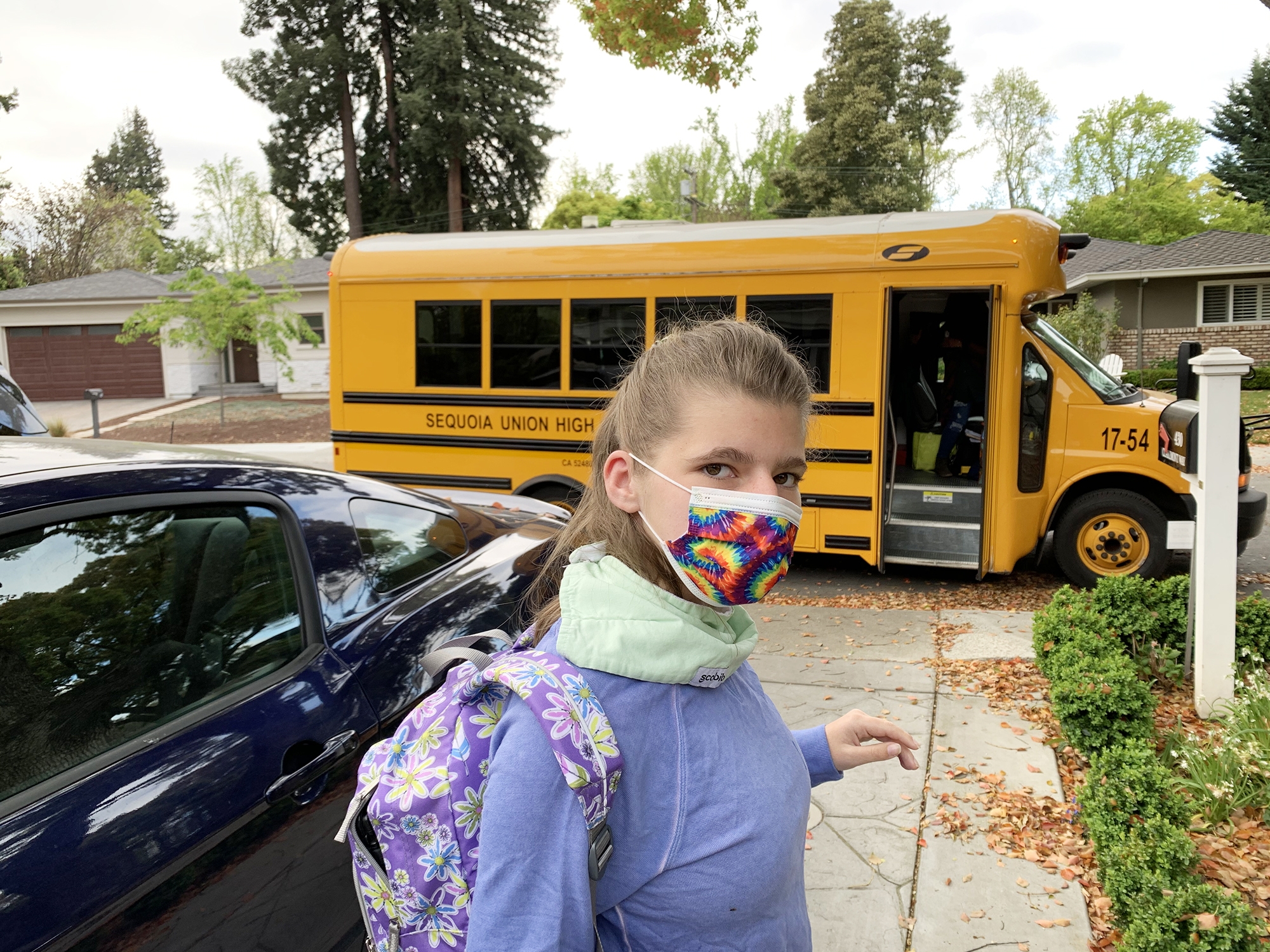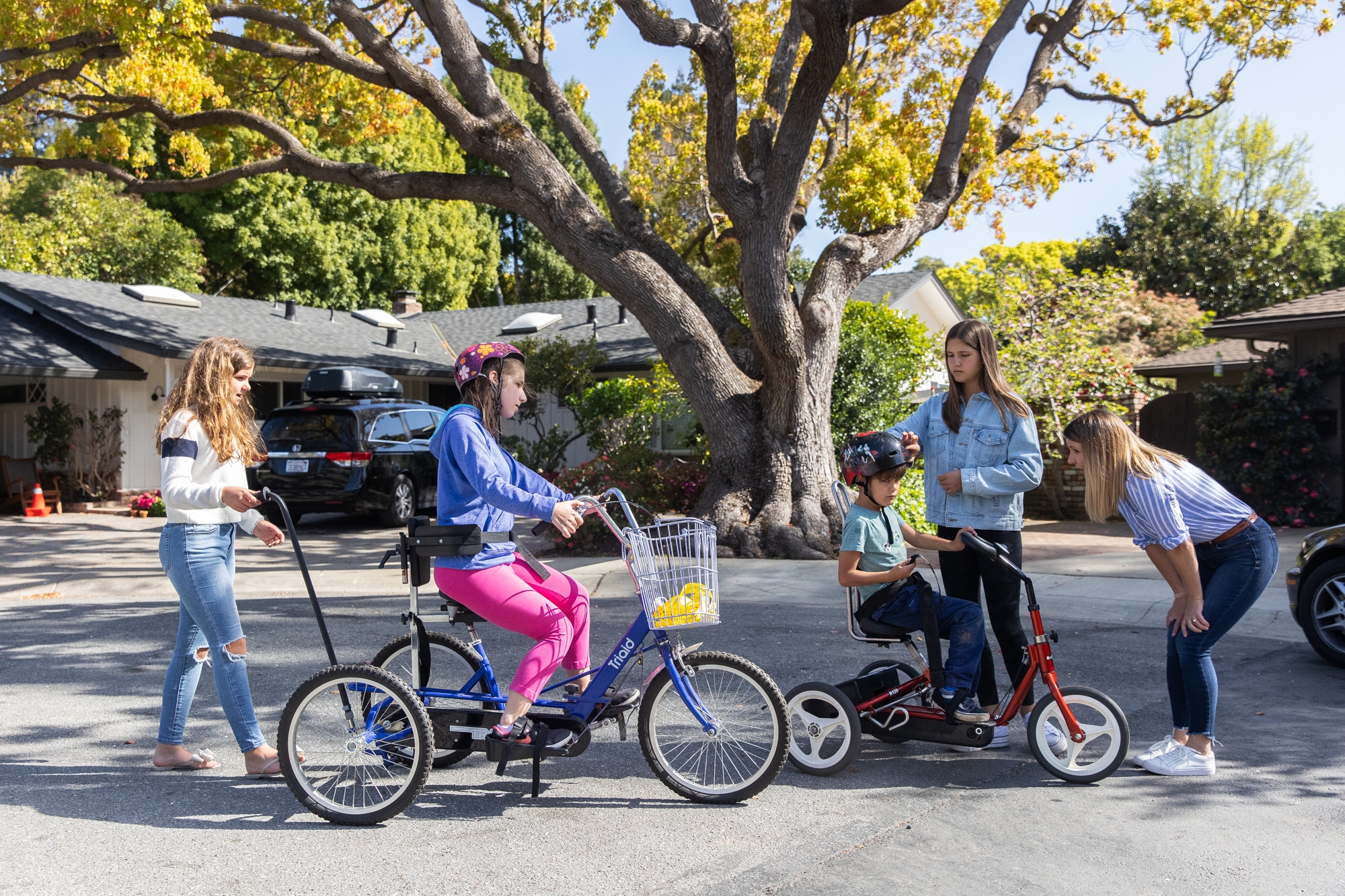Seventeen-year-old Tessa Nye sits crying on her computer in her family's Menlo Park home. Her mom Kim Nye explains that as a disabled student, online classes do not work for Tessa.
Although April 5 marked the first day Tessa and her peers at Sequoia Union High School's Independent Living Skills program could attend classes five days a week on campus, they lost more than a year of learning and socialization during the COVID-19 pandemic. Nye said she is perplexed that special needs students in the nearby Menlo Park City and Palo Alto Unified school district schools got to return to campuses nearly a year ago, while the Sequoia district couldn't pull this off.
"I have nothing but respect for (Tessa's) teacher and specialist, but it has absolutely sucked," Nye said.
Tessa has SLC13A5 deficiency, a condition that causes her to have seizures and leads to delays in expressive language skills, low muscle tone or a lack of muscle control, and episodes of body stiffening or weakness. As a result, she doesn't use a mouse effectively and slams the computer closed if Nye tries to take a bathroom break while she is talking with a teacher, her mother said.
"There are dozens of little boxes on a screen. … it's really just a distraction," Nye said.
While doing distance learning, Tessa started showing behaviors that hadn't been a problem before. Her 11-year-old sister Maggie will no longer sit next to Tessa on the couch because Tessa has pulled out her hair too many times, Nye said.
It's as if 30 years of disability rights had been "thrown out," she said, adding that she believed that her daughter's individualized education plan (IEP) was violated. She said on a short-term basis it was appropriate to move to online learning as districts figured out how to make in-person learning work, but distance learning went on for "way too long" for these vulnerable students.
The Zoom lessons felt like they were done simply to "check a box" for the district's 1,350 special education students, she said.
"The district has failed our children," Nye told the Sequoia Union High School District school board in a March letter.
She also spoke of her concerns Sequoia Union High School District during a March 10 board meeting.
"Our children cannot speak for themselves, so once again their rights are being violated," she said.
The California Department of Public Health released guidance on Aug. 25, 2020, permitting in-person targeted, specialized support and services in stable cohorts -- a group of no more than 14 children or youth and two supervising adults that stays together for all activities, and avoids contact with people outside of their group.
For several weeks before the April 5 reopening, Tessa was able to come on campus for a few hours a day under the supervision of a nurse, but this didn't offer a solution for families of other students who didn't have the bandwidth to fight for more assistance, Nye said.
Sequoia District Teachers Union President Edith Salvatore said that special education teachers and aides offered enrichment cohorts in the fall, on Wednesdays when lessons are asynchronous or after 3 p.m. on weekdays. Teachers were able to work with students on campus on a voluntary basis. Because of that, the number of students back in classrooms during the fall was not uniform across the district, she said.
When asked for comment, Superintendent Crystal Leach said in an email that the special education teachers are a part of a bargaining unit that negotiates its working conditions.
"They are bound by their contract and can only work under agreed terms and conditions. Once SUHSD signed an agreement with SDTA, it allowed for a portion of our in-person services and instruction to resume, which includes special education programming," Leach said.
'Piecemeal' solutions, 'do something for these kids!'
Jennifer Kaufman said her son Joe, 21, has lost his ability to communicate and other functional skills over the last year. He has Down Syndrome, and has delays in speech, adaptive, vocational, intelligence, motor and general independent skills, she said. He is part of the TRACE program at Sequoia High School, which serves young adults with special needs who are transitioning into jobs or community service.
Kaufman didn't appreciate that the district seemed to lump special education students in with the general population in this month's return campus, she told the district's administrators in a March letter. The general population students are on-campus for two days a week, then off for 10 days of school. She said that she was considering litigation against the district for denying her son's needs and not fulfilling his IEP goals.
Joe became disengaged, and doesn't understand that the faces on his screen aren't just people on TV, Kaufman said. It was hard for him to stay engaged and he could get very loud and disruptive, impacting her husband, who was trying to work from home and support Joe at the same time. She said Joe really needed an aide to facilitate online learning.
"We have done our best at being partners at home, but it's been a year; they've had a year to figure out how to get this," said Kaufman, who is a special education teacher in the Menlo Park City School District. The Sequoia district has said, "'Tthey don't have permission.' They're 'working on it.' They're 'getting close.'"
Everyone commiserates, but they're still not in school, she said before students returned on April 5.
TRACE is located on a separate campus within Sequoia High's campus, which makes it easy to isolate the 14 students in the program from others, she said.
"If (the district) really wanted to do it they would have," Kaufman said.
The district placed a financial burden on families to hire their own in-home aides and helpers that was "immense" and "unaffordable" for many in the district, according to Nye.
Families like Andi Dehne's ended up spending their own money to hire help for their special education students. Her son Riley, 19, has Down Syndrome and is in the Independent Living Skills program at Woodside High School, so she hired someone to help during the day with schoolwork, because she had to return to her job teaching kindergarten at Oak Knoll School in Menlo Park. She describes a "piecemeal" solution with her ex-husband and daughter pitching in to assist Riley during the school day.
There was a period when, every night at bedtime, he'd ask, "Coronavirus be over! Back to Woodside?" Dehne said. At times he'd get emotional and curl up on his bed because he missed being on campus so much, she said.
"Teachers did the best they could do with what they had (virtual school)," she said.
Riley returned to in-person learning last week. The district has offered him four days a week on campus from 10 a.m. to 2 p.m.
"It was extra hard on him as far as losing his community; it took him two years to acclimating to being at Woodside. ... I think so many of us, we were just waiting and waiting and waiting and waiting. Thinking: 'Do something for these kids!'"
Riley took part in a cohort that started in March, but it was only after school on four Mondays, outdoors with about four or five students, she said.
"I'm thrilled that he is back in person now," she said. "The big question is, God forbid we go through something like this again, how can we redesign our response to meet the needs of our most vulnerable learners?"








Comments
Registered user
Menlo Park: Central Menlo Park
on Apr 16, 2021 at 12:27 pm
Registered user
on Apr 16, 2021 at 12:27 pm
The teacher's union is too powerful, and the School Board is failing to look after the needs of the students. Parents are afraid to rock the boat because they fear subtle retaliation from teachers and schools. The schools exist to educate students, not to provide employment for teachers. Until parents organize and exercise power, students will suffer.
Registered user
Portola Valley: Central Portola Valley
on Apr 16, 2021 at 12:40 pm
Registered user
on Apr 16, 2021 at 12:40 pm
Thank you Almanac for highlighting this issue. My daughter is 17 and has Down syndrome. She has faired okay relative to many special needs students with more severe needs, and only because we were able to provide an aide for her at home. My heart breaks for the families that have not been as fortunate -- the majority. I've been horrified over the past year that SUSD was not able to find an in-person solution for this relatively small group of students on their large campuses. It would have been absolutely possible to follow CDC social distance guidelines given the numbers, and not doing so is nothing short of neglect, and an incredible injustice. It's hard to put into words how this has impacted these families on a day-to-day basis. I wish union leaders could spend even one day in these parent's shoes, let alone an entire year. Most students are back at least 2 days a week at this point, but it is still not enough.
Registered user
Menlo Park: Downtown
on Apr 16, 2021 at 3:55 pm
Registered user
on Apr 16, 2021 at 3:55 pm
I agree that students with IEPs did not have their legal obligations met during this challenging time. A full year? I understand going virtual in the beginning, but to stay virtual for a full year is just plain criminal. The teachers union and its leadership need to be revamped now that they are an obstacle to schools providing education. Lawsuits wouldn't have been necessary if the schools made an effort to bring at-risk populations on campus. We just chose to go private. Anyone that can afford to will too. It's so unfortunate as everyone deserves an equal education.
Registered user
Portola Valley: Central Portola Valley
on Apr 16, 2021 at 4:23 pm
Registered user
on Apr 16, 2021 at 4:23 pm
I fully support these parents' efforts to get their kids the education they need and deserve. Most schools across our State have largely failed children over the past year plus. While all children should have the opportunity to have a meaningful in-person education, the children featured in this article rise to the top of our youth that most need the consistency and support that in-person schooling provides. These parents are incredible advocates for their kids, but that advocacy shouldn't have been required.
Registered user
Menlo Park: University Heights
on Apr 16, 2021 at 6:41 pm
Registered user
on Apr 16, 2021 at 6:41 pm
I have had the same problems with our children's IEPs (I have two - one in SUHSD one in middle school). My children with IEPs only started attending in person school the week of April 5th. They had no contact with any teacher prior to that time. We have been gaslighted by one teacher's reports our children do not have any needs and are on grade level and do not need help (and that academic goals in IEPs should be changed or removed). In some ways, their work is probably on grade level because my husband and I are supervising all of it at home. We are reluctant to call IEP meetings because of an inappropriate "amendment" added when we tried to change remote resources that were not working.